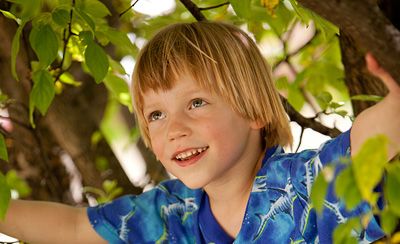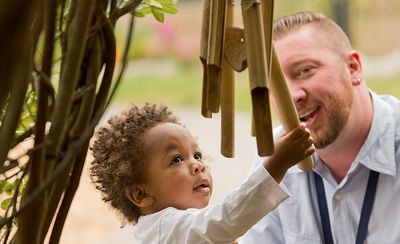What is the Outdoor Classroom?
Eric Nelson lays out the basic components of the Outdoor Classroom, and explains in simple terms what underlying problems it addresses.
| April 2013Eric Nelson's book, Cultivating Outdoor Classrooms, clarifies the vision of the outdoor classroom and explains how it addresses the needs of today's children. I hope these selections below encourage you to read this excellent book in its entirety.
The Outdoor Classroom's vision is simple: children benefit from spending more time outdoors, especially in natural places. Its goal is equally simple: to increase the quantity, quality, and benefits of outdoor experiences for children. Here is an overview of the key features of the Outdoor Classroom:
- The Outdoors is an Important Learning Environment
- Learning takes place outdoors that doesn't occur indoors. It is important, then, that outdoor environments be as richly and thoughtfully equipped as indoor ones. Children should be able to move seamlessly between indoors and outdoors; their play and learning should be as easy in one place as the other. Adults should not treat one location as more educational than the other.
- Freedom for Children to Play on Their Own
- A fundamental principle of the Outdoor Classroom is children's right to initiate their own activities. Children need to explore, imagine, try new things, and learn alone or with friends. Ultimately, what any of us learns most deeply is what we have explored "by ourselves."
- Learning Takes Time
- Too many adults who work with children try to hurry them. Pressuring children to hurry up inhibits rather than accelerates learning. Like almost everyone else, children learn best when they are relaxed and have open-ended time in which to create their own activities. They need time to refine and anchor new skills. The Outdoor Classroom encourages children to spend as much time as they want outdoors. The time children have is often directly related to the freedom they have.
- Children Need Physical Activity
- Physical activity is necessary for children's development and health. Open space offers children opportunities for big movement, vigorous social play, and explorations big and small. Their activities help them refine motor skills and teach them how the world works.
- A Full Range of Activities
- The Outdoor Classroom believes, "Everything you can do indoors, you can do outdoors, and even more!" Part of the Outdoor Classroom's vision is that indoor and outdoor spaces constitute a single learning environment.
- Comprehensive, Holistic, Emergent Curriculum
- Curriculum is one of the trickiest elements in ECE. How do we support children's development instead of imposing our own adult agendas on them? In the Outdoor Classroom, we view curriculum as more than the adult-designed course of study or activities. Instead, it is everything that happens during a child's day, everything that a child comes in contact with. Adults observe and respond to children's needs and interests, taking this expanded understanding of the curriculum into account.
- Engaged Children and Engaged Teachers
- Engagement is key to learning. Real learning occurs only when children become engaged with the environment and the people in it, usually through activities that they themselves initiate. Paradoxically, in ECE settings, this means that truly engaged teachers are often in the background, observing and responding rather than leading. Engaged teachers support children who are initiating their own learning.
- Developmentally Appropriate Activities
- The term "developmentally appropriate" in the Outdoor Classroom means that activities always lie within children's capacity to handle them and are never forced on children. Developmentally appropriate practices are fundamental to effective learning and to the well-being of children.
To the uninformed eye, the Outdoor Classroom may look like nothing more than children playing outside, as children always have. But play in the Outdoor Classroom means something much deeper. And that something is not just the next hot topic, the next new thing. Rather, it is a return to a very old thing: child-centered learning.
The Outdoor Classroom shifts ECE from a primarily indoor, teacher-initiated model to one that embraces outdoor, child-initiated play as critical to children's well-being. By moving children and their activities outdoors, the character and type of what they do are transformed. Children regain control over their activities and become responsible for their own learning and growth, supported by attentive adults who ensure their safety and stimulation. Teachers relinquish control to become observers and supporters.
The changes we have wrought in childhood in order to protect children from danger constitute a silent emergency. I call it an emergency because of the rapidly escalating negative effects it is having on children and society at large. I call it silent because the combined impact of several unintended consequences make it so damaging, yet the collective impact of these consequences is rarely discussed or addressed. I believe that the Outdoor Classroom can help early childhood educators address this emergency.
These are the seven most critical issues facing children today:
- Lack of exercise
- Preoccupation with electronic media
- Perception of outdoors as an unsafe place to play
- Isolation from and fear of nature
- Lack of engagement in and connection to the world, including nature
- Reductive approaches to ECE
- Epidemic use of behavior-modifying drugs on young children
The Outdoor Classroom helps to restore the traditional benefits of childhood while addressing these challenges by:
- Getting children outside and more active
- Involving children in hands-on, loose-parts outdoor play
- Creating opportunities to learn how to handle outdoor risks safely
- Connecting children to nature in ways that encourage them to connect more deeply
- Teaching children about cause and effect through outdoor and interpersonal activities
- Providing children with a wide range of activities that support their holistic development
From Cultivating Outdoor Classrooms: Designing and Implementing Child-Centered Learning Environments by Eric M. Nelson. © 2012 by Eric M. Nelson.
Reprinted with permission of Redleaf Press, St. Paul, MN;www.redleafpress.org








